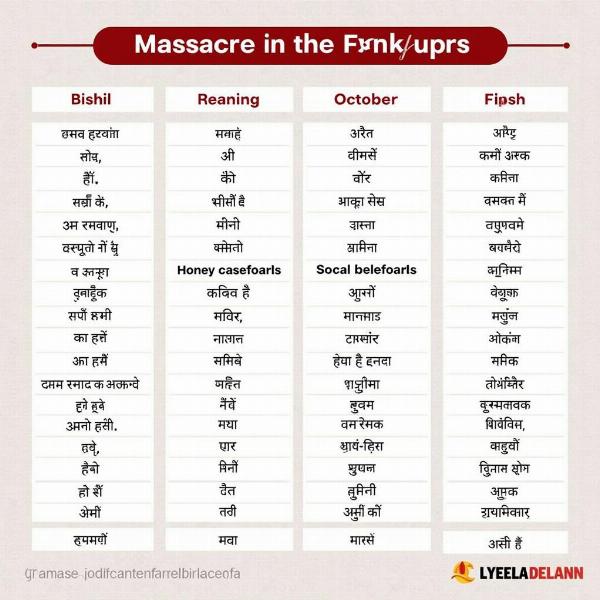Understanding the Hindi meaning of “massacre” is crucial for anyone engaging with Hindi language and culture. While a direct translation might suffice in some cases, grasping the cultural nuances and emotional weight associated with the word is essential for accurate communication. “Massacre” evokes images of brutal and widespread killing, a tragedy with deep historical and social implications. Exploring its Hindi equivalents provides valuable insight into how this devastating act is perceived and articulated within the Indian context.
Exploring Hindi Equivalents of Massacre
The Hindi language offers several ways to express the concept of “massacre,” each with its own subtle connotations and degree of intensity. Some common translations include nar-sanhar (नरसंहार), which literally means “human destruction,” and samoohik hatya (सामूहिक हत्या), meaning “collective killing.” Other terms like qatl-e-aam (कत्लेआम), borrowed from Urdu, emphasize the indiscriminate nature of the violence. The choice of word depends on the specific context and the desired emotional impact. For instance, nar-sanhar carries a strong sense of devastation and loss, while samoohik hatya focuses on the act of killing itself.
Cultural and Historical Context of Massacre in India
India’s history, unfortunately, includes instances of massacres that have left deep scars on the nation’s psyche. From the Partition riots to communal violence, these events have shaped the cultural understanding of mass violence. Understanding this context is crucial for comprehending the gravity and sensitivity surrounding the word “massacre” in Hindi. The term is not merely descriptive but also carries the weight of historical trauma and collective memory.
How to Use “Massacre” and its Hindi Equivalents Appropriately
Sensitivity and respect are paramount when discussing sensitive topics like massacres. It’s essential to avoid sensationalizing or trivializing the violence. When using the Hindi equivalents, choosing the most appropriate term for the context is vital. For example, using qatl-e-aam to describe a smaller-scale incident might be considered hyperbolic. Similarly, using nar-sanhar in a casual conversation can be perceived as insensitive.
 Hindi Equivalents of Massacre
Hindi Equivalents of Massacre
The Impact of Massacres on Language and Society
Massacres have a profound impact on language and society. They often lead to the creation of new vocabulary to describe the horrors witnessed and experienced. They also influence cultural narratives, shaping how communities remember and understand their past. The Hindi language reflects this impact, with words and expressions that carry the weight of historical trauma and collective grief.
The Importance of Accurate Translation
Accurate translation is crucial, especially when dealing with sensitive topics like massacres. Mistranslations can not only distort the meaning but also cause offense or misrepresent historical events. Understanding the cultural nuances and emotional weight associated with different terms is essential for effective communication.
Conclusion
Understanding the “hindi meaning of massacre” is not merely a linguistic exercise but also a cultural and historical exploration. It requires sensitivity, accuracy, and an appreciation for the emotional weight associated with the term. By exploring various Hindi equivalents and their contextual usage, we can gain a deeper understanding of how mass violence is perceived and articulated within the Indian context.
FAQ
- What is the most common Hindi word for massacre? Nar-sanhar (नरसंहार) is often considered the most common and impactful term.
- Is it appropriate to use qatl-e-aam in all contexts? No, qatl-e-aam emphasizes indiscriminate killing and might be inappropriate for smaller-scale incidents.
- Why is it important to understand the cultural context of “massacre” in Hindi? Understanding the historical and cultural context helps convey the gravity and sensitivity surrounding the term.
- What are some other Hindi words related to mass violence? Other terms include samoohik hatya (सामूहिक हत्या) and kathin mrityu (कठिन मृत्यु).
- How can I learn more about the history of massacres in India? Reputable historical resources and academic publications can provide further information.
Meaning-Hindi.in is your trusted partner for accurate and culturally sensitive Hindi translations. We specialize in various translation services, including business, legal, technical, website localization, educational, and specialized translations. Our expertise ensures that your message is conveyed accurately and respectfully, respecting the nuances of both Hindi and your source language. Contact us today for all your Hindi translation needs: Email: [email protected], Phone: +91 11-4502-7584. Let Meaning-Hindi.in bridge the language gap for you.